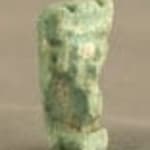Faience Shu Amulet, 664 BCE - 30 BCE
Faience
0.5 x 0.75
CK.0224
Further images
The first examples of amulets appeared in Ancient Egypt as early as 4000 B.C. Believed to possess magical powers that protected the wearer or bestowed upon the properties they symbolized,...
The first examples of amulets appeared in Ancient Egypt as early as 4000 B.C. Believed to possess magical powers that protected the wearer or bestowed upon the properties they symbolized, amulets were worn both by the living as well as the dead. Throughout their evolution, talismans were crafted from a variety of materials including precious metals such as gold and silver, semiprecious stone like jasper and carnelian, as well as other more affordable glazed compositions such as faience. The particular powers of an individual amulet were based upon its specific shape, although the material and even the color of the charm could affect its magical abilities. While many of the amulets created to be worn by the living could also be worn after death, there also existed a specific group of charms that were made specifically to be placed upon the mummified remains of the deceased. All together, amulets represent an important class of Ancient Egyptian art that furthers our understanding of their complex religious beliefs.
Shu was the primordial Egyptian god of the atmosphere and of dry winds. The name "Shu" is probably related to the root shu meaning "dry, empty." Shu also seems to be a personification of the sun's rays of light and the glow of the moon. In the Heliopolitan creation myth, Shu was, along with his sister Tefnut, one of the first deities created by the sun god Atum, either from his semen or from the mucus of his nostrils. Shu symbolizes dry air and the force of preservation. Tefnut symbolizes moist or corrosive air that brings about change, creating the concept of time. Shu and Tefnut were also said to be but two halves of one soul, perhaps the earliest recorded example of "soulmates." Tefnut became his consort, giving birth to the sky goddess Nut and the earth god Geb. Shu separated Geb and Nut (heaven and earth) by interposing himself between them. Depicted in human form, Shu often wears upon his head an ostrich feather (the hieroglyph for his name), and holds up the sky with two hands, one supporting it at the place of sunrise, and the other at the place of sunset.
Shu was the primordial Egyptian god of the atmosphere and of dry winds. The name "Shu" is probably related to the root shu meaning "dry, empty." Shu also seems to be a personification of the sun's rays of light and the glow of the moon. In the Heliopolitan creation myth, Shu was, along with his sister Tefnut, one of the first deities created by the sun god Atum, either from his semen or from the mucus of his nostrils. Shu symbolizes dry air and the force of preservation. Tefnut symbolizes moist or corrosive air that brings about change, creating the concept of time. Shu and Tefnut were also said to be but two halves of one soul, perhaps the earliest recorded example of "soulmates." Tefnut became his consort, giving birth to the sky goddess Nut and the earth god Geb. Shu separated Geb and Nut (heaven and earth) by interposing himself between them. Depicted in human form, Shu often wears upon his head an ostrich feather (the hieroglyph for his name), and holds up the sky with two hands, one supporting it at the place of sunrise, and the other at the place of sunset.





